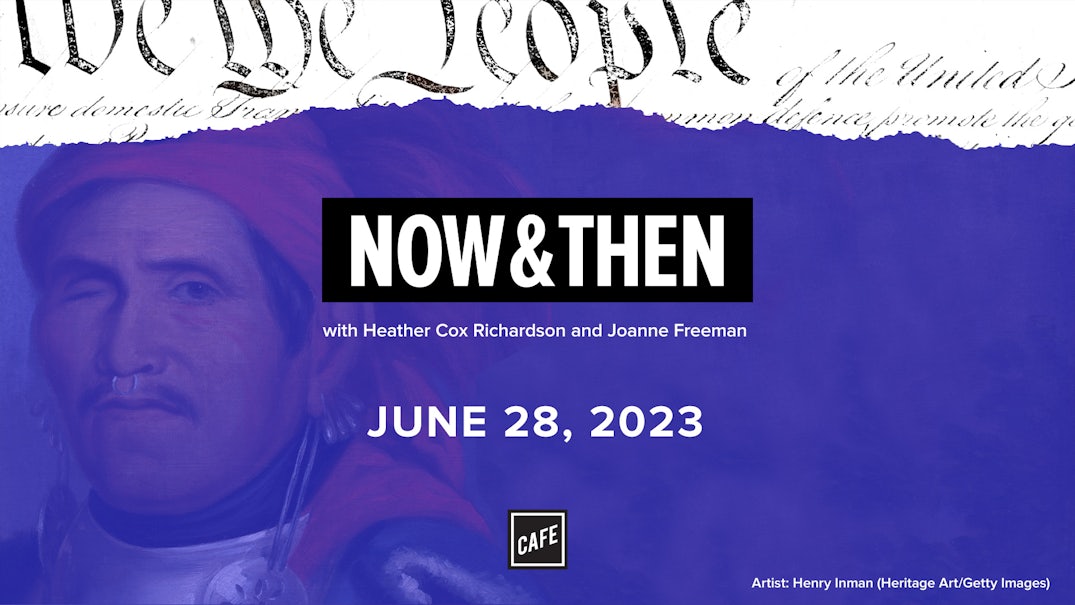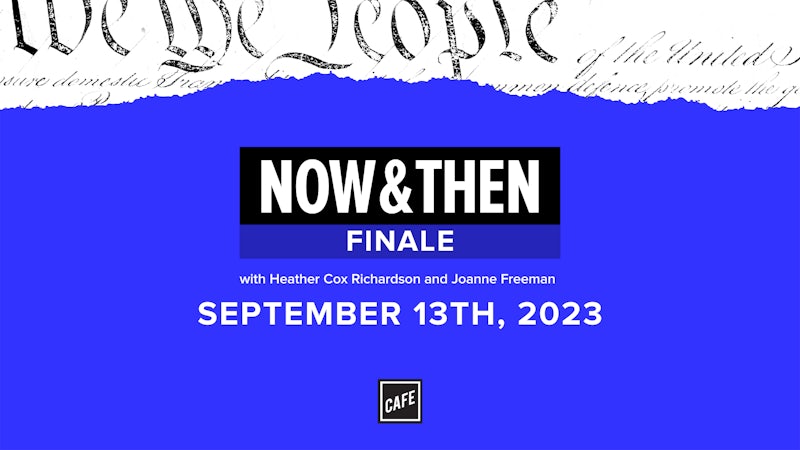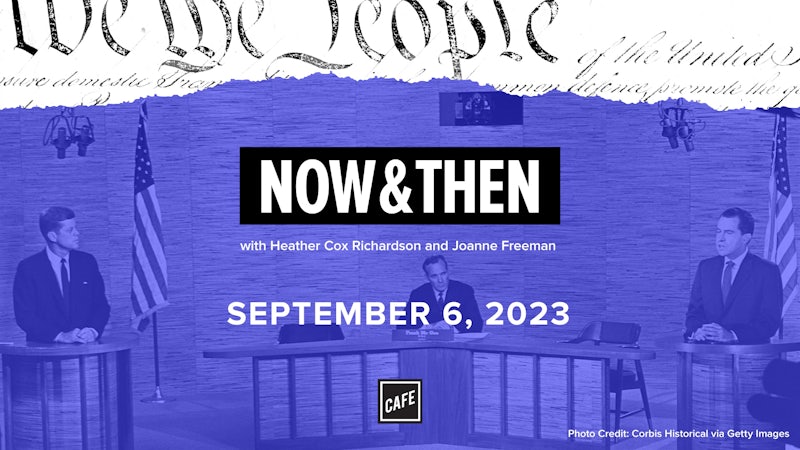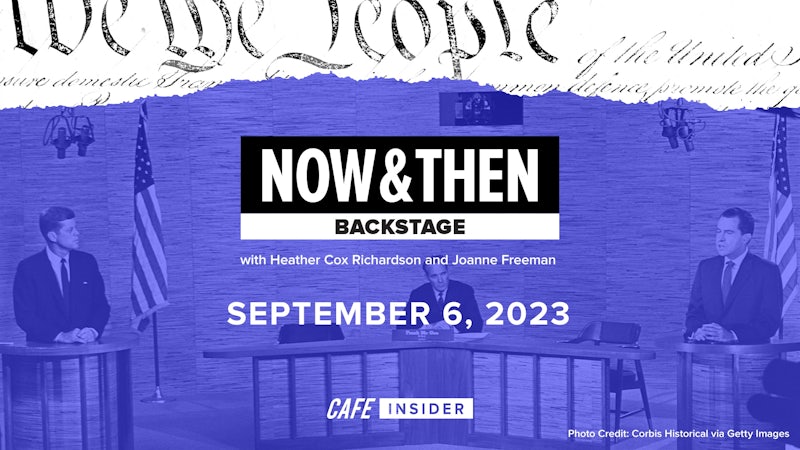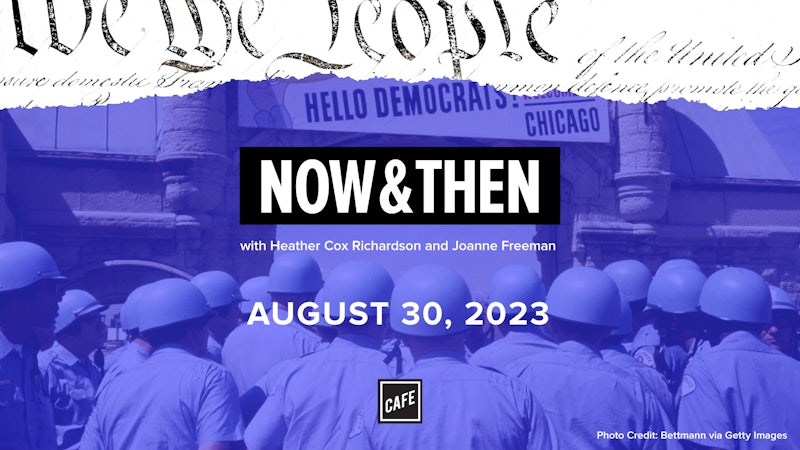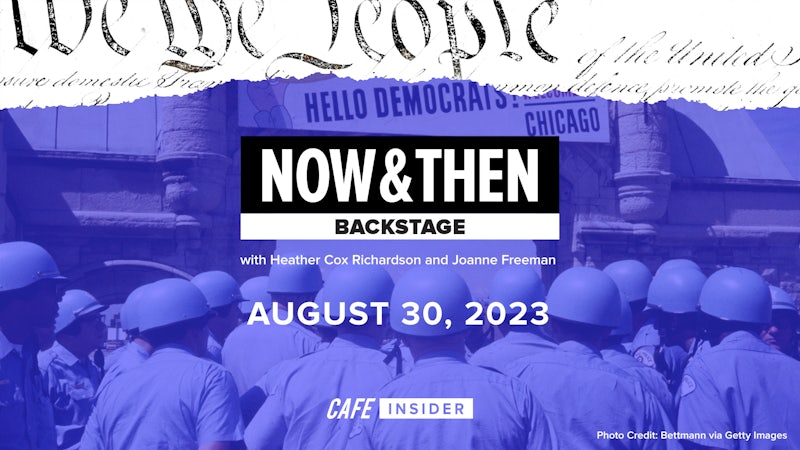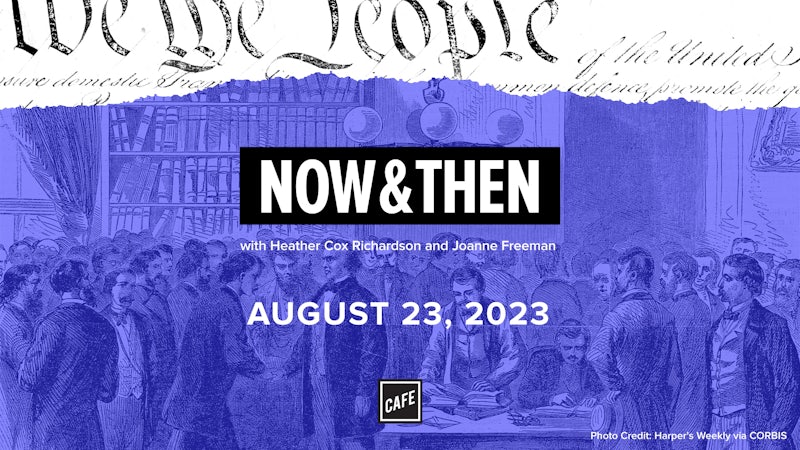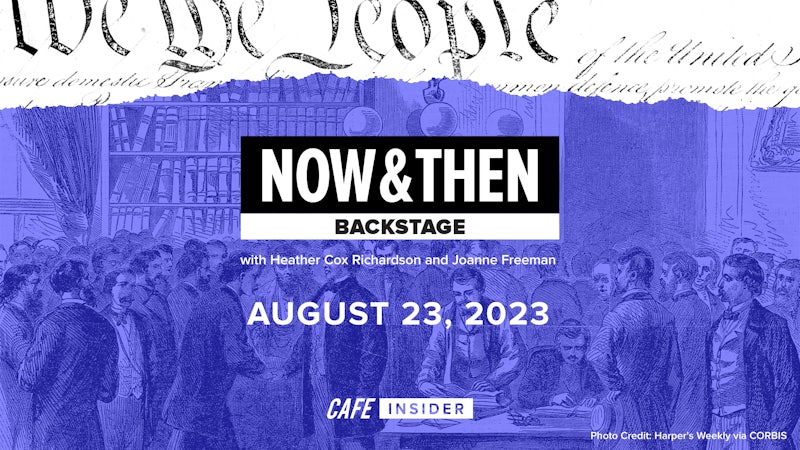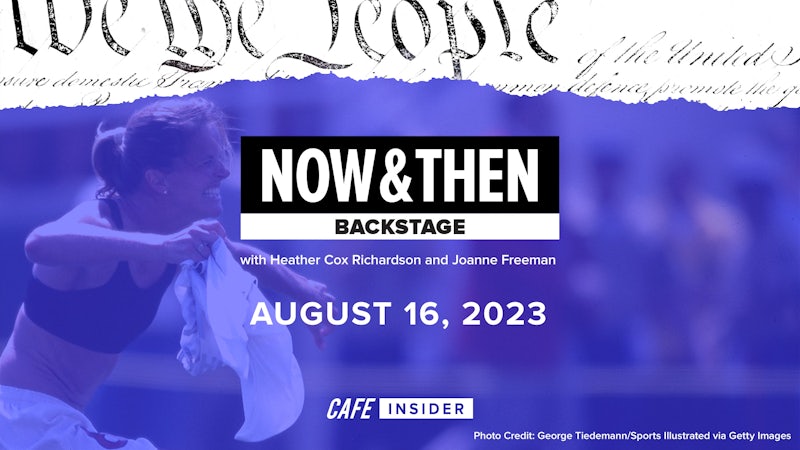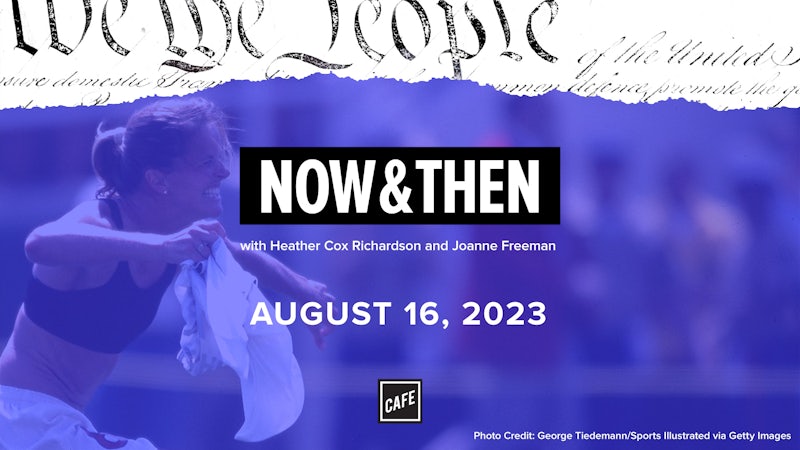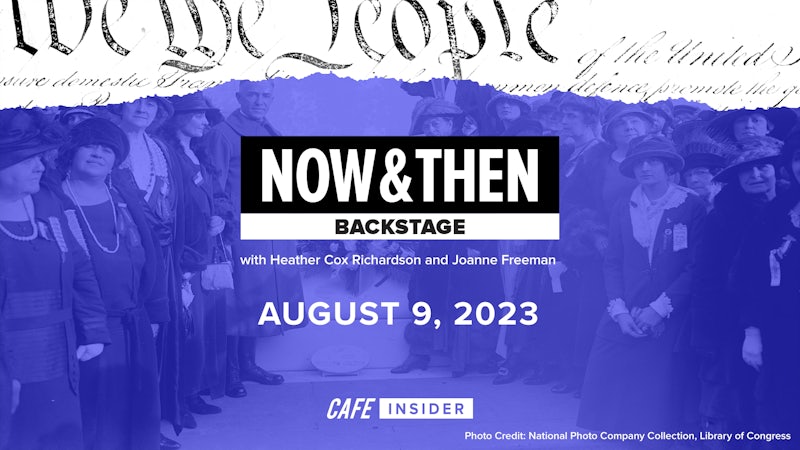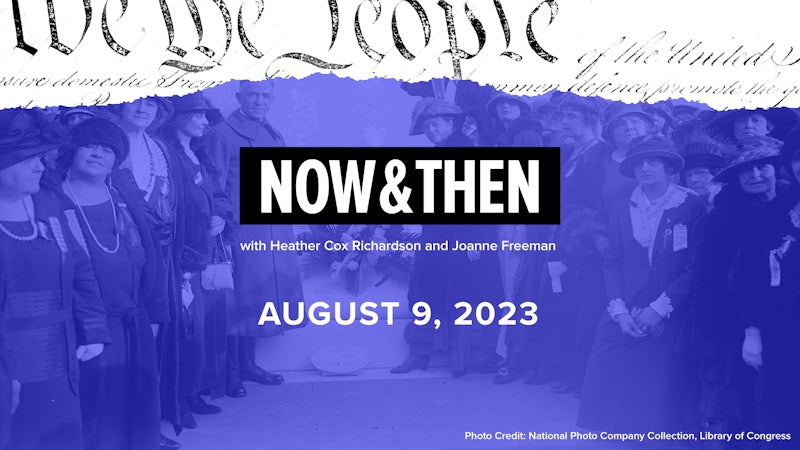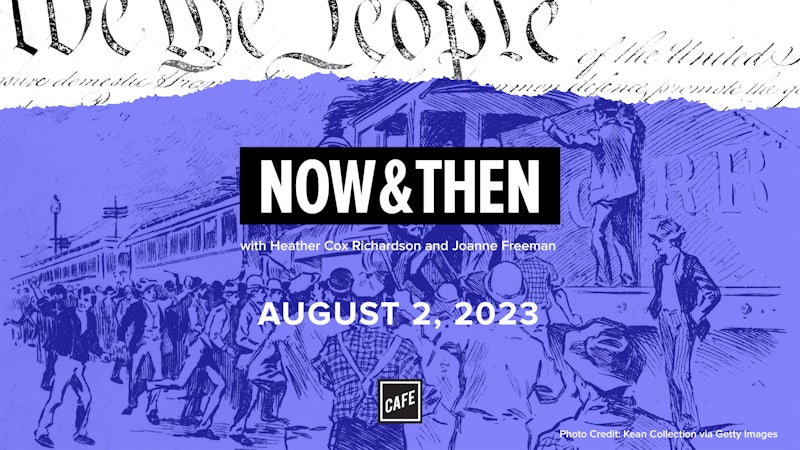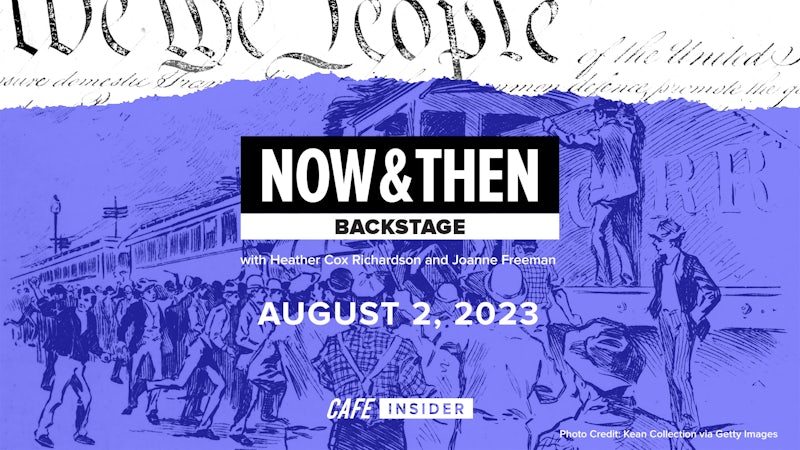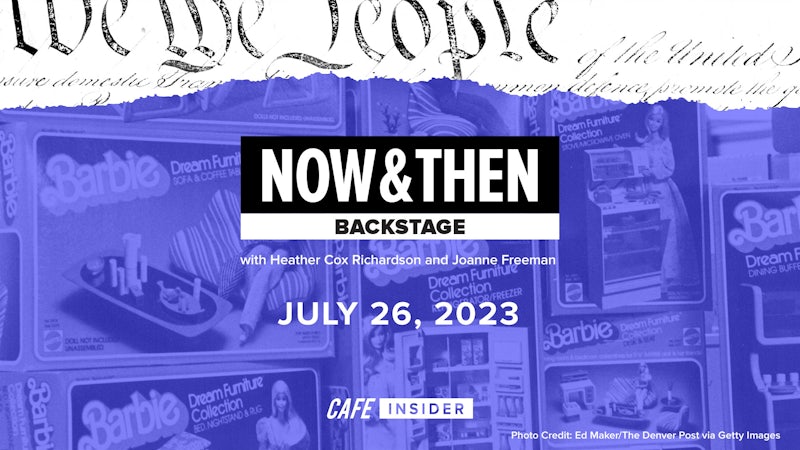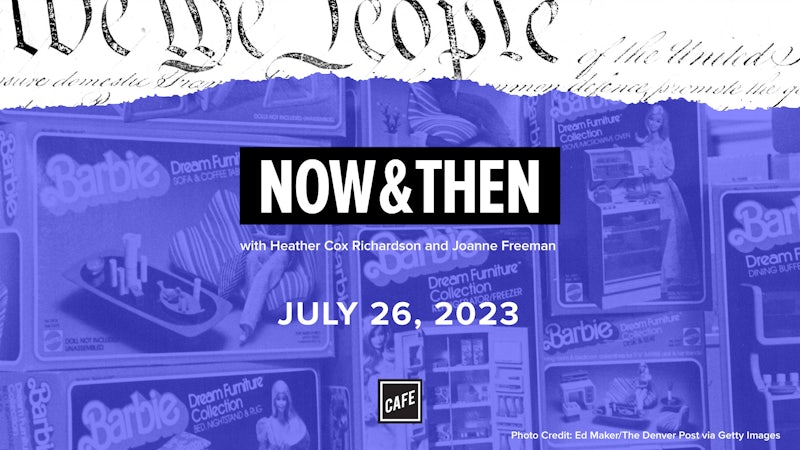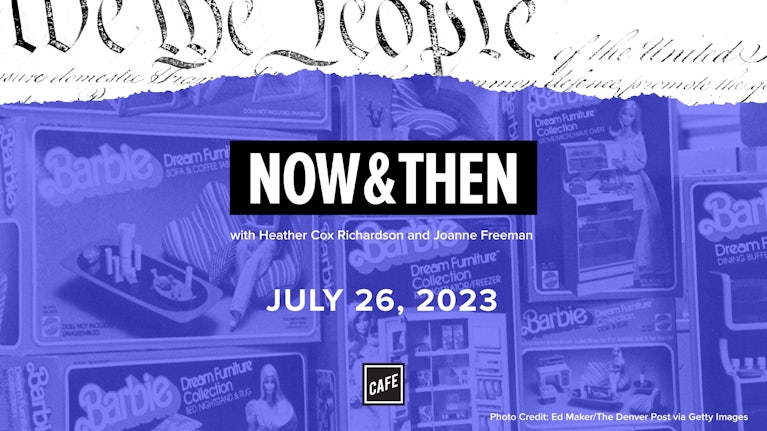Heather Cox Richardson:
From CAFE and the Vox Media: Podcast Network, this is Now & Then. I’m Heather Cox Richardson.
Joanne Freeman:
And I’m Joanne Freeman. Today, we’re talking about an issue that grows out of a recent Supreme Court decision, Haaland v. Brackeen, which directly focuses on and highlights some aspects of indigenous American history. The ruling upheld key provisions of the Indian Child Welfare Act, which was a 1978 law, aimed at keeping Native American adoptees with their tribes and traditions. So the case in the end was a victory for tribal sovereignty. Now, that comes after a long history of American institutions and the American government separating Native American children from their families for any number of reasons, supposedly to educate them, to quote, unquote, “Americanize” them and distance them from their tribal heritage and culture. It’s a longstanding issue, the question of the status and relationship of indigenous American peoples with the American government and what that has to do with their culture, their sense of themselves, American national identity, and any number of other things. It goes right to the heart of how we define being American.
Heather Cox Richardson:
And that particular decision highlighted the ways in which indigenous history reflects all of American history. The Indian Child Welfare Act established three preferences for the placement of indigenous children when they were adopted or put into foster care, first saying that they should put with the child’s extended family, then to the child’s tribe, and then finally, to members of another tribe. So the idea behind the Indian Child Welfare Act was to push back against that long history of trying to erase indigenous culture. But what was additionally interesting about Haaland v. Brackeen was that the state of Texas, along with non-native adoptive parents, challenged the Indian Child Welfare Act on a number of arguments. But one highlighted argument was that, the law was unconstitutional because it took away power from the states to handle family matters, and it also said that the law violated the constitution’s guarantee of equal protection by allowing discrimination based on race.
That is, in this case, the tiered system placed indigenous adoptive parents over parents of other races. So what we had in this case was the central question that’s illuminating virtually all of our politics right now, is the relationship between states and those who want to return power to the states, the federal government, and then also of course, the communities and the individuals who have historically been discriminated against and who is supposed to be in charge of the relationship between all members of a society, is it the states, who don’t have a very good track record? Is it the federal government, who has stepped in to change the ways in which states have discriminated against certain populations, who is really supposed to be taking care of these central issues? And then thrown on top of that, very clearly, is a long pattern of discriminatory behavior that has caused extraordinary hardship to a population.
Joanne Freeman:
From the creation of the Constitution, the question of sovereignty was huge, who are you sovereign to? And divided sovereignty, can you be sovereign to a state and sovereign to a nation at the same time? And the American system of federalism, where sovereignty is essentially divided but it’s left deliberately amorphous, and we are living in a time, and it’s certainly not the first time, that who is responsible, the nation or the state, is being bounced all over the place, that question goes all the way back to the founding of the nation and was left deliberately murky. That is what made some people willing to accept a national government, was the fact that it would not necessarily supremely control everything.
This larger question profoundly shaped the indigenous American population, and in other ways, the United States as a whole. Part of what happens early on, and this is I think anyone who studies early American history has to grapple with this fact, that you have indigenous tribes, you have Indian nations, and you have the United States trying to figure out how to interact with seemingly these Indian nations, but in a way that’s going to benefit the United States government and not necessarily the indigenous people.
So if you think about the fact that we had any number of Indian treaties early in American history, it was a constant process of negotiation, partly because the United States was constantly trying to find new ways of getting land. But a treaty seemingly is something between two governments. And as a matter of fact, in the early 19th century, the Supreme Court Justice John Marshall, in a series of important cases dealing with this larger question about nations, and treaties, and sovereignty, he grappled with precisely what indigenous tribes or indigenous nations were. And the phrase that he came up with, and it’s wonderful because it’s just as murky as everything else we’re talking about here, he said, tribes were quote, “domestic dependent nations.” Now, if it’s a nation, is it dependent? That phrase, if you try and pull it apart, is very hard to find a meaning for. And that’s deliberate, that’s on purpose, because it’s hard to define.
As a matter of fact, Marshall says the words treaty and nation are words of our own language selected in our diplomatic and legislative proceedings by ourselves, having each a definite and well understood meaning. And we have applied them to Indians as we have applied them to other nations of the earth. He’s trying to figure out exactly what the relationship of the American government with indigenous peoples are, and he’s looking at this fundamental fact, are they nations or are they not? And every time there’s a treaty, treating a tribe as another nation, that suggests that logic underlies it.
Heather Cox Richardson:
Though I hear that, and I hear unincorporated territories from the turn of the last century, and behind that idea of our incorporated territories is always money.
Joanne Freeman:
Oh, yeah.
Heather Cox Richardson:
So I’m like, yeah, John Marshall-
Joanne Freeman:
Well, he has to design it.
Heather Cox Richardson:
… they want that land.
Joanne Freeman:
Oh, it’s always about land and money, but it is also true that even though that’s the underlying logic here, there still has to be a way to grapple with it, to deal with it, to talk about it, to frame it.
Heather Cox Richardson:
Yeah, I love the layers of all this. So if we’re getting the idea by the 1830s from the Supreme Court that indigenous nations are dependent sovereign nations that the states can’t deal with, only the federal government can deal with, the same way only the federal government can deal with other foreign nations, where’s that coming from?
Joanne Freeman:
We’re talking about the law, we’re talking about sovereignty, but obviously, culture, and indigenous Americans being able to preserve their culture in the face of this ongoing treaty-making and land-seizing, that’s an eternal huge problem as well. And a great example of this struggle being carried out in person takes place in the early 19th century. This involves two brothers, Tecumseh and Tenskwatawa, they’re both Shawnee Indians. And Tecumseh, from the beginning, is a person who is known as a hunter and a warrior, Tenskwatawa, not so much. Tecumseh becomes a resistance leader against American encroachment in the Northwest Territories. And although he and his Shawnee allies fail in a big battle, The Battle of Fallen Timbers, still, it has an impact on Native Americans, the Shawnee, how they see themselves in relation to settlers and the government.
Now, in 1805, Tenskwatawa has a vision in which he died and the master of life showed him a paradise and began communicating with him. And what the vision essentially taught him, as he taught it and explained it, was that Indians should turn away from European goods, European customs, they should no longer drink alcohol, they should basically turn away from these people who have been marching in and, in one way or another, shaping Indian culture, Indian life. And this is the part that I find particularly interesting, he wanted to create some kind of Pan-Indian movement, bringing Indians together in this effort to create this bigger, stronger community that could contain its own identity.
Heather Cox Richardson:
Well, and the timing matters here, in that, the Battle of Fallen Timbers, which is a hugely important battle, not huge numbers of people involved, but what it does is, it results in the Treaty of Greenville of 1795, in which the indigenous tribes in the Ohio region, which is a huge region, it’s not just the state of Ohio, end up seeding most of that territory. So in the wake of the huge land loss, the Shawnee begin to focus on culture and on creating a pushback against Euro-American encroachment through the deployment of culture, but also, one of the things that jumps out to me about this is, his economic vision is actually very suited to the environment in a way the Euro-American vision of a time is not. So the culture that he is embracing and the idea of not just… it is a Pan-Indian movement, it’s a religious Pan-Indian movement, but, me, everything’s about the economy, right?
Joanne Freeman:
And agriculture.
Heather Cox Richardson:
Well, that’s just it. Part of it’s like, he’s ahead of his time going, their system ain’t going to work, let’s pre-envision this in a different way.
Joanne Freeman:
Well, and whereas the American version of that, consistently and certainly throughout the late 18th and early 19th century is, if it’s friendly towards indigenous Americans, then the attitude is, you’re going to become us. We’re going to impose who we are on that land, and you will become us. They’re not adapting or thinking about the land or the people on the land, they’re just saying, “Well, we’re going to spread, and if this all ends well, you’ll just merge.”
Heather Cox Richardson:
Yes, you’ll become us. Exactly. And it’s not until the early 20th century that we get the idea from anthropologists that all cultures are created equal, if you will. There is still, until the early 20th century, the conviction among Euro-Americans that, “Everybody wants to be like us. This is the only way to do it.” And you think about what might have happened had they had, as the historian Elliot West puts it, “More imagination to be able to say, ‘Wait a minute, that system seems healthier than ours in some way. Let’s see how that works.'”
Joanne Freeman:
Well, more imagination, and less insecurity and fear, and greed.
Heather Cox Richardson:
Well, and isn’t that the theme of life, that if you can imagine that other people have value, you might be able to imagine a better future? Anyway, that was a depressing thing to say. But Tenskwatawa, what happens to him?
Joanne Freeman:
So Tenskwatawa, his ideas become popular, and he and his brother, Tecumseh, establish a new village near the site of that Treaty of Greenville, and they receive members of several different tribes who come and join that village and bring some of Tenskwatawa’s teachings back to their tribes. He also traveled to Delaware villages in early 1806. So he’s traveling around spreading his message, and other indigenous Americans are joining him, either to share in his effort or to take it and bring it back to where they’re from, as a movement, as an effort. For a while, it’s going swimmingly. So ultimately, Tenskwatawa creates this larger village to house and feed the increasing number of indigenous travelers who are, again, headed his way, joining his growing Pan-Indian movement. So in early 1808, he found a new village in Indiana territory called Prophetstown.
Heather Cox Richardson:
Now, in the meantime, the governor of the territory of Indiana at the time is William Henry Harrison. And he is eager to expand the land that comes under the control of the United States, and very eager to get Indiana statehood. And he’s very worried about Tenskwatawa and Tecumseh and their increasing influence, and he tries to push other tribes away from that message.
Joanne Freeman:
Now, a natural occurrence happens that actually, at this point, as Harrison and Tenskwatawa are, at least, in one way or another, grappling with each other, something happens that really benefits Tenskwatawa. On June 16th, 1806, it was predicted that there was going to be an eclipse. And Tenskwatawa said to his followers, “Guess what? There’s going to be any eclipse,” although what he says is, the sun will darken, the sun will undarken, “And this is going to happen, and I predict it. The master of life has told me.” And of course, when it happens, he gains even further renowned, he gains even more power because nature seemed to be following according to his prediction. This is part of why he ends up needing to create that larger village in 1808, Prophetstown, because now there are even more people joining up with him.
Heather Cox Richardson:
And there is this moment in which it looks as if he and Harrison, William Henry Harrison, might be able to work together with this large village, he needs more provisions. And so he actually reaches out to Harrison to see if he will help to supply Prophetstown. And Harrison invites Tenskwatawa to spend two weeks with him at his home in Indiana Territory. And they got along. Harrison and Tenskwatawa started to trust each other, and Tenskwatawa did that in part by positioning his new religion as peaceful, but also as a way to bring white faith systems into the indigenous population. The governor then wrote to the Secretary of War suggesting an alliance with Tenskwatawa, saying, “The influence which the prophet has acquired will prove advantageous rather than otherwise to the United States.” At the same time, though, he was continually trying to get more land, and in September of 1809, helped to complete the Treaty of Fort Wayne, which took another 3 million acres in Indiana and Illinois territories from indigenous populations and gave them to the United States.
Joanne Freeman:
So at that point, not surprisingly, Tenskwatawa breaks away from Harrison for a little while at least getting along, and Prophetstown and Tenskwatawa and Tecumseh prepare for some form of conflict, with Tecumseh coming to the fore as a real military leader at this moment. So Tenskwatawa, in 1811, ends up encouraging an attack on Harrison’s forces at the Battle of Tippecanoe. Many of you have already heard the phrase, the Battle of Tippecanoe, and Tenskwatawa says that the master of life has said that the indigenous forces will be impervious to bullets. And although Harrison’s troops suffer heavy losses, they end up repelling the attack. They burned down Prophetstown, and Tenskwatawa and Tecumseh end up joining with the British during the war of 1812.
Tecumseh is killed by American forces in 1813, and Tenskwatawa ends up fleeing the battle, remains in Canada, and ultimately dies really with very little recognition at all. Now, Tippecanoe and Tyler Too!, when William Henry Harrison runs for president, that campaign phrase, Tippecanoe and Tyler Too! that’s building on this battle as a way to campaign that, “Look at him, he’s this great guy, fought the Shawnee and other Indians at the Battle of Tippecanoe.”
Heather Cox Richardson:
So that moment, the rise of an early attempted Pan-Indian movement, the attempt to make an alliance with the United States, that falling apart when it turned out that the indigenous people were split, and some of them agreed to sign away huge amounts of land, and then the territorial governor of Indiana riding to the presidency on it seems like such a perfect microcosm of all of the issues we’re talking about here. So there aren’t a lot of reasons to remember William Henry Harrison. I can’t believe I said that, I’m going to get so much hate mail. But the fact that he fought in that battle and seemed to lead a war against a Pan-Indian movement was enough to help put him in the White House in 1840.
Joanne Freeman:
Right. So it’s the fact that it put him in the White House, and also, not only was it enough, but it was celebrated and advertised, and what he’s worth is he did this. So you’re absolutely right, it captures that moment and it captures the ideals and innocence, the ideology, the mindset, the mental landscape of people at that time, given that logic of that campaign.
Heather Cox Richardson:
And Indiana’s not even a state at that point, but the fact that a territorial governor is acting in such a way that it’s going to vault him into the federal government, along with the issues of sovereignty, and culture, and power among indigenous Americans, they’re all right there. And I have to say, I hate to, but I have to say, it’s one of the ways we get Benjamin Harrison, who’s a younger relative of William Henry Harrison. Benjamin Harrison ain’t got nothing going for him except a very famous name, and he’s going to be the person who presides over the Wounded Knee Massacre.
The next piece that we wanted to talk about actually happens right around the time of the Wounder Knee Massacre, and that is an attempt upon the part of the federal government to figure out a different way to incorporate indigenous Americans into the Euro-American system. And that’s known as the General Allotment Act, more popularly known as the Dawes Act, which is backed by Massachusetts Senator Henry L. Dawes in 1887. And it authorizes the president, who at the time was Democrat Grover Cleveland, to carve up reservation land into allotments. And one of the things that is really important, I think, about the Dawes Act is the recognition that Dawes was seen as a good guy, Dawes was a reformer, he was seen as being a real advocate for indigenous Americans.
He’d been an abolitionist. He had designed the law to try and enfranchise Indian Americans when he pushed through the Dawes Severalty Act, and he was trying to do good things, and that’s not at all how it played out. And in part do good things in the sense that, once again, he couldn’t recognize that getting rid of indigenous culture might not be the best way forward. The Dawes Act designated 160 acres of farmland or 320 acres of grazing land to each indigenous family who signed up to be enrolled in the Dawes Program. And anybody who effectively abandoned their tribal ways of life and showed what he called, the habits of civilized life, would have citizenship. And again, we’ve talked so much about citizenship here, and it’s so astonishing that indigenous Americans were excluded from citizenship in places like the 14th Amendment. So initially, the system was designed to be dependent on the consent of indigenous Americans, but Dawes certainly expected that they would all want to take advantage of the situation.
Joanne Freeman:
Dawes stated pretty clearly what his thoughts were, and again, seeing himself as someone who is aiming to do good for indigenous people, he explained his reasoning for the act as he lobbied for it in 1885. He said, “I feel just this, that every dollar of money and every hour of effort that can be applied to each individual Indian, day and night, in season and out of season, with patience and perseverance, with kindness and with charity, is not only due him an atonement for what we have inflicted upon him in the past, but is our own obligation towards him in order that we may not have him a vagabond and a pauper, without home or occupation among us in the land.”
Heather Cox Richardson:
And a lot of reformers agree with Dawes on that, believing that the federal government’s protection of indigenous tribes on reservations by then were actually holding tribal members back, that they would never really enter the American economic system and be able to prosper within that system so long as they were held apart from the rest of Americans. The reality though was much more complicated, and we’re really going to focus here on the parts of the act that concerned the Cherokees, the Creeks, the Choctaws, the Chickasaws, and the Seminoles, who were known at the time as the Five Civilized Tribes. One of the pieces to remember about the Dawes Act is that the reservations were much bigger than the amount of land that would be needed to allot the acreage that was assigned to every indigenous family. So at the same time that Dawes can say, “I’m trying to protect the rights of indigenous Americans to rise to prosperity through the American economic system,” all that land that they’re going to start calling surplus land is land that Euro-Americans want, not least for railroads, but also for Euro-American settlers. So that’s always in the mix.
Joanne Freeman:
The idea of allotting land to indigenous Americans would’ve seemed such a wonderful thing that, of course, people would take the government up on with no concern at all being given to culture.
Heather Cox Richardson:
Yes. And one of the pieces of that is one of the things that sinks the good benefits, if you will, of the Allotment Act in places like Oklahoma, for example, when indigenous families choose land allotments based on kinship and proximity rather than on the economic viability of that particular land, that is, they would rather have poorer land that is close to a sister, for example, than they wanted land that might be close to a railroad. And the different cultural values that went into allotments made a huge difference in the later benefits of the land in places like Oklahoma. So that started right off as being an issue. The initial attempts to allot land, again, to those indigenous Americans who were willing to take up allotments, got into trouble really quickly through bureaucratic messes, they didn’t really know how to do this, there were all kinds of funny pieces of the law that made it very hard to work.
Indigenous Americans begin to lose their land, as they suspected was going to happen. And in fact, at the end of the day, about two thirds of land that had been indigenous land in 1887 ended up being seeded as a direct result of the act and of its enforcement. And then what happens is that the timing of the Allotment Act was actually really unfortunate, because it becomes law in 1887, and then Benjamin Harrison becomes president in 1888, loses the popular vote, but becomes president anyway, and he is determined to take as much indigenous land as is humanly possible because he’s backed by the railroads and really wants to back the railroads. So the first four years of the Allotment Act were a complete mess. And then in 1892, Grover Cleveland is elected back into office. And Cleveland actually cares a lot about the indigenous laws, and trying to make sure that the indigenous laws are as fair as they can be.
Unlike Harrison, Cleveland is actually trying to do what’s right. So he tries to fix the Dawes Commission to work out the issues. And Dawes by then was out of the Senate, so he made Dawes the chair of the commission. Dawes becomes the chair of the commission, and very quickly, is pressured by his political compatriots, he’s in the Republican Party, Cleveland is a Democrat, to be heavy-handed and to allot the land really quickly and to claim the rest of the territory that has been given up by indigenous Americans under the Dawes Act. The Secretary of the Interior, who is going to become Georgia Governor and is a southern Democrat from this era, writes a memo to Dawes telling him what the goals of the commission should be.
Joanne Freeman:
It’s about as blunt as you can get. Smith writes to Dawes and says, “Success in your negotiations will mean the total abolition of the tribal autonomy of the Five Civilized Tribes and the wiping out of the quasi-independent governments within our territorial limits. It means, also, ultimately, the organization of another territory in the United States and the admission of another state or states in the union.”
Heather Cox Richardson:
Again, a really important moment because this is the 1890s, when, especially in the American South and the American West, there’s a move to do things, for example, like getting rid of the 15th Amendment to the Constitution. So the indigenous Americans are very much a part of that push against the idea of equal rights. So while we’re talking about indigenous Americans, it’s very much a window into a larger period. So the Dawes Act gets amended a number of times, including in 1898 by the Curtis Act, which gave the Dawes Commission control over enrollment, letting members of the commission force resistant individuals onto the roles, even against their will, and giving them an allotment. And that seating of lands and the forced entry into allotment is part of what I was just talking about in Oklahoma, but it also is what gives enough land to Euro-American settlers in Oklahoma, to make Oklahoma big enough to apply for statehood in 1907.
The indigenous Americans who are forced into allotments often choose their land not to enter the Euro-American system of the economy, but rather to try and keep their culture intact. And by 1909, the whole thing is a complete mess. The Dawes Commission has bogged down in legal disputes, there’s accusations of bribery and fraud, indigenous Americans continue to push back against it.
Joanne Freeman:
This quote from the new Commissioner of Indian Affairs, Robert G. Valentine, shows you at least where some people are at this point, when the Dawes Commission gets bogged down, when this whole thing is a mess, when we already had Smith, the Secretary of the Interior saying, “Well, this is going to wipe out sovereignty.” Now, in 1909, we have Robert Valentine, Commissioner of Indian Affairs, and this is what he says, “It is possible to do only one of two things with the Indians, to exterminate them or to make them into citizens. Whichever we choose should be done in a business-like way. If we choose extermination, we should do it suddenly, painlessly, and completely. But instead of frankly engaging in that course, the country has set itself to make the Indians into citizens. It has no business to bungle this job, as it is now doing, any more than if the course of extermination were now to be decided, on it would have any business to bungle that.”
Talk about blunt. So there, Valentine is saying, “We can only do two things with Native Americans, we can exterminate them or make them citizens, merge them in with us.” What’s striking about that? That’s 1909. Go all the way back to 1809, and that same sentiment was being expressed very much in that same way. So we’re talking about all of this change in policy, in law, in assumptions, in culture, but on a certain level, there’s this ongoing thread dealing with indigenous Americans as a people that are separate, apart, and ultimately need to be us.
Heather Cox Richardson:
And then there’s this huge pushback against this. So this was supposed to be this great reform effort in 1887, and it’s such a mess by the early 20th century. And a young reformer named John Collier starts to lobby for getting rid of the Dawes Allotment Act, and gets put at the head of an investigating committee to look and see what the heck happened. In the 1920s, the Institute for Government Research, which is later going to become the Brookings Institution, and the Rockefeller Foundation, which funded it, put together a commission to take a look at the actual conditions of indigenous Americans under the current Indian policies. And the resulting report, called the Meriam Report, was absolutely devastating. It said, “The discrimination against indigenous Americans has created an extraordinary health crisis, economic crisis…” I mean, it’s really, really ugly, in the 1920s, when Americans are like, “Hey, we figured out the economy. Everybody should be doing great.” And the Meriam Report says, “Not so much with indigenous Americans.”
And in response to that, during the New Deal, in 1934, the Congress passes the Indian Reorganization Act, which is designed to restore cultural power to indigenous Americans. But look at the timing, 1934, so it was a great idea, but 1934, it returns the power of control over culture and a number of other issues in the indigenous communities to those communities themselves. But it’s the freaking depression. Right when everybody else is relying on federal government help, the federal government says, “Oh, man, we should not have gotten involved. We’re going to back off.” The timing is like… We should do an episode someday on the world’s worst timing. And the truth is, people like Collier are not trying to undercut indigenous Americans, they’re doing the opposite. This is not, “We’re setting you up for failure here,” this is, “We are trying finally to make it right.”
But the timing… I mean, if it had been 10 years earlier when the economy was booming, things might have looked very different. So after the Indian Reorganization Act of 1934, there’s, of course, going to be World War II, and a real effort to incorporate indigenous Americans more fully into American society. And one of the things that the federal government looks at in those years, after the war, the 1950s, is the extraordinary poverty on the reservations. And there are a number of indigenous Americans who want to leave the reservations but simply can’t afford to, at the same time that the government thinks it would be just a great idea to get more workers into urban areas. And so in 1956, we get the Indian Relocation Act, which is, again, designed to move indigenous Americans off of rural reservations into urban areas.
And that’s going to change the nature of the relationship of indigenous Americans primarily to each other, but also to both the state and the federal governments. Because what it does is, it brings indigenous Americans from a variety of tribes into urban areas, where they’re going to lose contact with their own individual tribes, from whatever particular reservation they’re with, but build new kinds of ties to indigenous Americans from other tribes and from other reservations. And from that, we’re going to see the rise of a new kind of Pan-American Indianism, or Pan-Indianism, in the late 20th century that’s going to give rise to a whole different kind of struggles between the federal government, state governments, and the tribes.
Joanne Freeman:
So this leads to, for all of the reasons that Heather just mentioned, the creation of the American Indian Movement, which is founded by a group of Minnesota-based indigenous Americans, Dennis Banks, George Mitchell, Eddie Benton-Banai, and Clyde Bellecourt. And all of these men had difficult childhoods, they’re activists, but they’re in this urban environment, and are subject in that urban environment in a variety of different ways, to prejudice, to being imprisoned, being put in jail based on deliberate policies on the part of the police there. Dennis Banks comments, at one point, he and several of these men end up, at one point or another, being imprisoned. And Dennis Bank ultimately blames this in part on, surprise, opportunistic police, who he says, “Stake out, quote, unquote, ‘Indian bars’ in areas where indigenous people are hanging out, and arrested indigenous Americans on trumped-up charges so that they could get arrest quotas.”
And Banks says, in his words, “During the early ’60s, I got caught in the dragnet maybe 20 times. Monday mornings, I would sometimes end up at the workhouse, or they would put me to work on a farm. Once, this happened to me three weekends in a row. I would go back to the same bar and get caught again. It took me a while to realize that the police raided on the Indian bars and never the white ones.”
Heather Cox Richardson:
Well, it reflected the fact that, although, in the 1960s, less than 1% of the Minnesota population was indigenous, 8% of the prison population was indigenous. And you can see how somebody like Banks gets the reputation then of being a criminal, simply because he’s being swept up in these dragnets.
Joanne Freeman:
This is now the words of Clyde Bellecourt, another one of the founders of the American Indian Movement. Bellecourt, talking about this struggle and this ongoing urban attack on indigenous Americans, he says, “I tried to work within the system for four years as an activist, demanding a fair share of it for my people, but all the money was controlled by the churches and bureaucracies, and they weren’t interested in any programs that might have led toward real economic independence for the Indians.” And so this is the point at which Bellecourt and his other co-founders create what they want to be, this American Indian Movement, an independent movement that will create community driven responses to some of the ills that are facing indigenous people in Minnesota and beyond. This Indian movement group that was being formed was initially called the Concerned Indian Americans, but the acronym, CIA, presented obvious problems.
An older indigenous woman, Alberta Downwind, who was becoming an involved with this nascent movement, she suggested American Indian Movement, AIM, A-I-M, thinking, rightly, that that really reflected the action-oriented goals of this program. One of AIM’s first programs was the AIM Patrol, which was a civilian street patrol that filmed and cataloged police abuse toward indigenous Americans in the Twin Cities, broke up fights before police intervened, and provided free legal advice for detained or charged indigenous Americans. And they were inspired in part by an existent Minneapolis Black Patrol as well as the similar Black Panthers Patrol in Oakland, California. This is fascinating partly because we see all of these things now, street patrols, people cataloging or filming abuse, trying to break up fights, ways in which people are coming forward in a variety of ways to try and stop what is obviously the imposition of force, deliberately, over a variety of different populations.
And it makes perfect sense that this is all rising in the 1960s, which is a moment when concern about and awareness of civil rights is on the rise, and the creation of all kinds of movements is also on the rise. It’s in the air at this moment. And so here you see AIM, the Black Panther Patrol, and any number of other things coming up to try and deal with the problems being imposed on them in urban environments.
Heather Cox Richardson:
I think two things are important about that, one is the fact that so many indigenous peoples had ended up together in those cities, and found each other and recognized that they had similar concerns, and that those similar concerns were actually the same concerns as lots of dispossessed or marginalized Americans in the same period.
Joanne Freeman:
And that the best way to deal with that was not within the system, but to form these independent movements that could directly address the problems at hand. Now, Bellecourt describes the climate at this point, when this movement is forming and this awareness is forming. He says, “Soon we had all sorts of people showing up to help, many non-Indians among them, we had nuns, neighborhood people, and even young law students, like Larry Leventhal, now a very well known attorney, but then just a bushy haired kid who was passionate about justice. The Minneapolis Black community had their sole patrol on the north side. We merged our efforts and worked as a unified protective force in our communities.” Really striking, and again, it shows this transition, from trying to work within the system to actually creating organizations, with an aim and a goal and some kind of organization that, as Bellecourt says in this quote, is attracting all kinds of other people who have an interest in justice, is really striking. And again, really, it fits in with what’s in the air in the 1960s and the early 1970s.
Heather Cox Richardson:
And you know what I love about that, is that the unity across all these groups to come together outside the system is actually a way to enforce the ideas of fairness, and justice, and equality before the law that theoretically the system’s supposed to be based on. So in a way, it’s like a popular self-correction to a system that has gone out of control.
Joanne Freeman:
And it bears witness.
Heather Cox Richardson:
And it bears witness, and it says, this is not… these movements almost always get categorized in, at that point, the mainstream as being radical, and yet what they’re asking for is extraordinarily conservative, we want the rights that are guaranteed to us by the Constitution and are established in the Declaration of Independence. And I think it’s perfect, that AIM actually gets funding from the Department of Housing and Urban Development to create an indigenous preference, low-income housing settlement, known as The Little Earth Project, which launches a number of anti-violence initiatives, and volunteers from the Little Earth Project ran community patrols after the police murder of George Floyd in May and June of 2020. They taught people in Minneapolis deescalation techniques, they bought lights for parks, they protected local businesses, and they’re praised throughout the city. So that idea of indigenous culture representing the traditional values of community and also of the Declaration of Independence to return the idea of fairness to our system, absolutely comes full circle from Tenskwatawa to George Floyd.
Joanne Freeman:
The point you just made also is a wonderful way of putting it too. It’s easy to point to groups like this and say they’re radical because they’re outside of normal systems of government and they’re independent, and in that sense, they’re scary. The important point that you just made is, they’re looking for the most traditional conservative rights that Americans are entitled to. They’re not promoting violence or doing anything that we might call radical, they’re asking for traditional rights, and they’re working as a movement to help secure them in community-oriented ways. That’s what they’re doing. So the Little Earth Project is in 2020, it really does bring us full circle, but what we see, still, this is a different kind of community, but it’s still a group of people promoting and bettering themselves as a group because the larger government isn’t necessarily serving them in that way, and grappling with the rights that they, as well as any number of other troops, deserve simply as American citizens.












